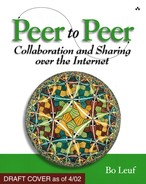Chapter 6. Instant Messaging
Theoretical considerations aside, after selection and installation comes the time to actually use the technology. Then we must address such issues as usability, performance, reliability, availability, and of course security.
Part of this practicality must be determined by the selection of software and network model. However, the whole is always more (or less) than the parts, and when the dynamics of a practical network come into play, nothing is quite as it seemed on paper. Time after time, a seemingly decent design is committed to use only to reveal interesting and unexpected flaws determined by its context of usage.
In this part of the book, we therefore examine some of these issues from the perspective of real implementations, sorted by chapter into application groups, and provide in-depth analysis of how some common, and sometimes not-so-common technologies work. In this and the following chapters, the presented solutions may not always be the recommended ones for every deployment situation but are sometimes selected simply for the complementary light they shed on the others.
This chapter introduces a number of popular technologies for instant messaging (IM), most of which turn out to be rather different in their internal workings than one would suspect based on their common “p2p” moniker. This analysis of messaging technologies starts off with some of the older, often proprietary, but still widely used p2p solutions, and this relative age shows in their implementation details.
The later solutions are newer, usually more open, and should prove more interesting for many readers in terms of future deployment potential. Taken together, all solutions should give considerable insight into messaging technology.
